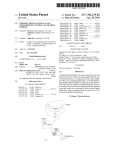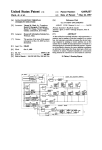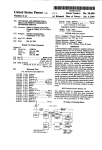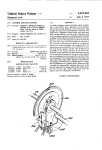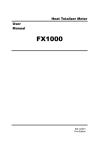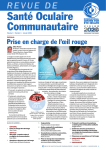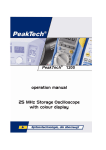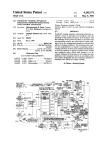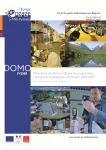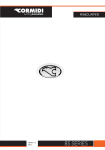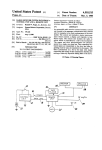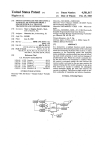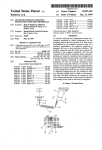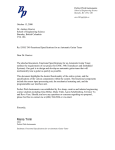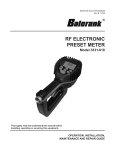Download “state rm
Transcript
United States Patent [19] [11] Patent Number: Samuels et al. [45] [54] PROCESSOR WITH SPEED INDEPENDENT 5,065,173 Date of Patent: [56] Nov. 12, 1991 References Cited FIXED FILM SPACING us. PATENT DOCUMENTS [75] Inventors: James T. Samuels; Roger D, 4,057,817 11/1987 Korb et a1. ........................ .. 354/298 Ellsworth, both of Rochester, 4,300,828 11/1981 Kaufman ...... .. . .... .. 354/322 . _' [73] Asslgnee' Eastman Kodak Company’ Rochester, N.Y. Primary Examiner—A. A. Mathews Attorney, Agent, or Firm-G. Herman Childress [21] Appl' No‘: 495’867 [22] Filed. Mm, 19 1990 An automatic ?lm processor sets new reference devel oper chemical temperatures and ?lm transport speeds in [57] - ' ’ ABSTRACT accordance with user input at a keypad and establishes a new delay time to provide constant ?xed spacing Related U.S. Application Data [63} along the transport path between trailing edge of one Continuatiomimpm of sen NO. 494,647, Man 16, 1990, Pat_ No_ 4,994,331 ?lm sheet and lead?ngedge of a next ?lm sheet regard. less of transport speed. “Wait” and “ready” lights are controlled to signal when a next sheet is to be fed. A [51] Int. Cl.5 ............................................. .. G03D 3/08 microcomputer calculates the delay time and loads a [52] [58] counter- A buzzer signals countdown to zero. US. Cl. ............................ .. 354/298; 354/322 Field of Search ............. .. 354/298, 319, 320, 321, 354/322 14 Claims, 3 Drawing Sheets 6/ g27 I CLOCK “state SENSOR I <26 m H COUNTER --1 SENSOR £37 §50 —— 1 __ Q44 S'Q‘IDT‘JCEH <43 (:7 MICROCOMPUTER OVERRIDE SWITCH TEMPERATURE SENSOR 36‘ Q g9 ‘52 HEATER HEATER CONTROL >—— BUZZER 5/ "" g (48 MOTOR <53 CONTROL __ SHAFT SPEED SENSOR ANNUNCIATOR CONTROL rm 30) _ ‘ 54 ROLLERS 34 55 TRANSPORT 33 US. Patent Nov. 12, 1991 Sheet 2 of 3 5,065,173 FIE-‘m3 k > < + I07 NO YES (08 DESIGNATE NEW REF. SPEED I LOAD COUNTER WITH SPACING TIME Q03 A DESIGNATE NEW SPACING TIME coum /04 SET SPACING T|ME=NEW SPACING TIME ‘ YES (Ill . v n 'r . COUNT = =0 ER TURN OFF "WAIT" a /05 NO TURN ON "READY" V gl/Z souwo YES 5/06 BUZZER TURN Oél "WAIT" TURN OFF "READY" FIEQS COUNT+I US. Patent Nov. 12, 1991 Sheet 3 0f 3 5,065,173 hmoawzqkmEwJOI S mm I856 D3km 53 wo5:38 _-S0E5 _512586 B m» “11%w ‘ @062E26 RV il ? .6528 50.6 vn _ mO Zwm ImJO 1 5,065,173 2 ing may be controlled by a ?xed set time interval be PROCESSOR WITH SPEED INDEPENDENT FIXED FILM SPACING tween the entry into the processor of the trailing edge of the ?rst sheet and the time when the user is signalled to enter the next sheet. When the entry of the leading edge of the ?rst sheet into the processor is detected, an annunciator in the form of a “wait” light is illuminated This is a continuation-in-part of commonly owned, copending US Pat. application Ser. No. 07/494,647, ?led Mar. 16, 1990, now U.S. Pat. No. 4,994,837, enti tled “Processor With Temperature Responsive Film Transport Lockout.” BACKGROUND OF THE INVENTION The present invention relates to processors of ?lm to signal that the required spacing has not yet been attained. At a set time after the entrance of the trailing edge into the processor has been detected, the “wait” i0 light is extinguished and a “ready” light is illuminated. Although conventional processors used for radio graphic image processing are traditionally con?gured and similar photosensitive media, in general; and, in to operate at a constant ?lm transport speed, modi?ca particular, to a processor having means to vary trans-~ port speed and including means to maintain ?xed inter tions may be made through gear changes and the like to vary the process. Moreover, new processors are being ?lm spacing regardless of transport speed. introduced which are usable in more than one mode. Photosensitive media processors, such as the Kodak X-OMAT processors, are useful in applications such as The mode is often referred to in shorthand fashion by a nominal ?lm transport “drop time”, which may be de ?ned as the time from entry of the leading edge of a sheet of ?lm at the feed end until exit of the trailing edge of the same sheet of ?lm at the discharge end. Conven the automatic processing of radiographic ?lms for med ical imaging purposes. The processors automatically transport sheets or webs of photosensitive ?lm, paper or the like (hereafter “?lm”) from a feed end of a ?lm transport path, through a sequence of chemical process tional processors operate in standard (90 second), rapid (45 second), or “Kwik” (30 second) mode, and can be ing tanks in which the media is developed, ?xed, and varied to operate in an extended-cycle mode, such as washed, and then through a dryer to a discharge or 25 described in L. Taber & A. G. Hans, “Processing of receiving end. The processor typically has a ?xed ?lm Mammographic Films: Technical and Clinical Consid path length, so final image quality depends on factors including transport speed which determines length of eration," Radiology, Vol. 173, No. 1, pages 65-69, Oct. cessor “chemistry”). In a typical automatic processor of the type to which the invention relates, ?lm transport speed is set at a tissue. The new processors will be settable as to run 1989. In the latter mode, processor speed is lowered and time the ?lm strip is in solution, and the temperature chemistry temperature is raised to enhance image con and composition of the processing chemicals (the pro 30 trast for better detection of changes in density of ?brous parameters, including transport speed in order to be able to use the same processor for multiple processing modes. constant rate and the chemistry is de?ned according to a preset recommended temperature, e.g. 93° F., with a 35 speci?ed tolerance range of +/-X° F. A temperature control system is provided in the processor to keep the chemicals within the speci?ed range. It is desirable, in a processor having selectable trans port speed, to be able to maintain a ?xed inter?lm spac ing during transport regardless of the transport speed setting. Conventional systems that operate on a ?xed time interval to determine ?lm spacing are inadequate for this purpose. When faster transport speeds are se Conventional processors usually include a ?lm width sensor in the form of a reflective infrared sensor array adjacent a feed entrance opening, and may also include lected, the same ?xed time interval will give a spacing that is too great. When slower transport speeds are like for detecting separation of entrance rollers due to selected, the same interval will give a spacing that is too the passage of ?lm sheets at the front end of the trans small. portation path. The ?lm width sensor not only provides 45 One prior art arrangement, described in U.S. Pat. No. an indication of the width of a sheet entering the proces 4,300,828, sets spacing using a feed counter clocked by sor, but may also provide an indication of the occur a drive shaft encoder. A microcomputer loads the feed rence of the leading edge and trailing edge of each counter with a number corresponding to the number of sheet, since the signals from the ?lm width sensor will shaft encoder pulses needed to drive the trailing edge of a feed detector in the form of a Hall effect switch or the change signi?cantly as each leading and trailing edge is 50 the sheet past a particular point of the transport path. encountered. Information as to leading and trailing edge occurrences and width of the ?lm, taken with prior knowledge of the constant transport speed, is used to keep track of cumulative total ?lm surface area pro cessed in order to guide chemistry replenishment con 55 When the count reaches zero, a feed annunciator is actuated and a “wait” light is turned off. There is no teaching or recognition in the ‘828 patent of using such a shaft encoder system in a processor whose transport trol. The use of a separate entrance roller detector sig speed is settable. Moreover, the mechanical nature of the encoder limits programming flexibility. nals that a sheet of ?lm has actually entered the nip of the ?rst roller pair, and is not just sitting still on the ?lm guide under the width sensor. SUMMARY OF THE INVENTION It is an object of the present invention, in a processor When sheets of ?lm are sequentially fed into a proces 60 utilizing a ?xed time period between trailing edge of a sor, it is desirable that a spacing be maintained between ?rst sheet and leading edge of a second sheet, to provide the trailing edge of a ?rst sheet and a leading edge of a a system for varying the ?xed time in response to varia next one in order to avoid overlap. The spacing should tion in transport speed, so as to maintain a ?xed inter be enough so that overlap is avoided even though one ?lm spacing to avoid overlap regardless of ?lm trans or both of the sheets suffer some slippage and/or skew 65 port speed. ing along the transport path, but not so great that pro It is another object of the present invention to pro cessing time is unduly affected. For a particular con vide an annunciator to signal the attainment of recom stant ?xed transport speed processor, proper ?lm spac mended ?lm sheet spacing in an automatic processor 3 5,065,173 4 con?gured to operate at a plurality of ?lm transport 24 comprising oppositely-disposed pluralities of air dis speed settings. pensing tubes 25 or some other appropriate ?lm drying mechanism. Positioned proximate opening 15 is a sensor 26, such In accordance with the invention, a processor of exposed photosensitive media having means for auto matically transporting ?lm along a path through devel oper, ?xer, wash and dryer stations and means for moni toring the entrance of a trailing edge of a particular medium into the processor, further comprises means responsive to user input for setting system parameters including a desirable transport speed, and means for determining and signalling the passage from entrance of that trailing edge to the time to feed the next medium at a desired ?xed optimum spacing. In one aspect of the invention, described in greater detail below, processor ?lm transport speed is set ac cording to user selection of a processor operating mode, and annunciators in the form of “ready” and “wait” lights are controlled in accordance with a determination of lead time needed to assure maintenance of a desired linear spacing between successive sheets of ?lm, for the particular processor mode setting. A microcomputer determines the number of clock counts to be loaded into a counter responsive to setting of the transport speed. BRIEF DESCRIPTION OF THE DRAWINGS Embodiments of the invention have been chosen for purposes of illustration and description and are shown in the accompanying drawings, wherein: FIG. 1 is a perspective view of a processor in which as a conventional universal ?lm detector board, re?ec tive infrared sensor array which provides signals indica tive of sheet width when a sheet F1, F2 is presented at the entrance opening 15. The ?lm width sensor 26 also provides an indication of the occurrence of passage of the leading edge and trailing edge of each sheet past point 26 of the processor 12. A second sensor 27, in the . form of a magnetic reed switch 29 or the like (FIG. 3), may be provided to detect separation of entrance rollers 28 to signal the beginning of transportation of a sheet of ?lm along the path 16. Sensor 27, as shown, is a Hall effect sensor and has an actuator or slug 32 mounted on a rocker arm 36 for movement about a pivot pin 37, from the solid line to the dot-dashed line position, in response to separation of the upper entrance roller 28a from the lower entrance roller 28b. Other sensors may also be used. In FIG. 2, the sheet path 16 is shown as de?ned by a plurality of ?lm transport rollers 30 and a plurality of guide shoes 31 located to direct a sheet of ?lm F sequen tially through the tanks 21, 22, 23 and dryer 24. The rollers 30 form the transport system for transporting the sheets F1, F2 through the processor 12. Crossover as semblies act at the interfaces between the respective tanks 21, 22, 23 and dryer 24 to transport sheets between the corresponding stations. Rollers 30 may be driven in conventional manner by a common drive shaft 33 (FIG. a ?xed ?lm spacing system in accordance with the pres ent invention can be employed; FIG. 2 is a schematic representation of relevant ele 4) having alternating right-hand and left-hand axially ments of the processor of FIG. 1; spaced worms for driving adjacent columns of rollers FIG. 3 is a fragmentary view of an entrance roller 30 at the same speed in counterrotation, so as to move detector usable in the processor of FIGS. 1 and 2; 35 the sheets F1, F2 in the direction of the arrows along FIG. 4 is a block diagram of the ?xed ?lm spacing path 16. Drive shaft 33 may be connected by a no slip system employed in the processor of FIGS. 1 and 2; and chain drive and toothed sprockets (not shown) to be FIG. 5 is a flow diagram of the operation of the sys driven by an electric motor 34 such as, for example, a tem of FIG. 4. variable speed brushless DC motor. Throughout the drawings, like elements are referred The temperature of developer chemical in tank 21 to by like numerals. may be controlled by means of a recirculation plumbing DETAILED DESCRIPTION OF THE PREFERRED EMBODIMENTS path 35 (FIG. 2) having a pump P for drawing devel oper out of tank 21, through a thermowell or other suitable heater and ?lter, and then passing it back to the The principles of the invention are illustrated, by way 45 tank 21. A temperature sensor 37 (FIG. 4) is provided in of example, embodied in the form of a ?xed ?lm spacing the tank 21 or recirculation path 35 to monitor the tem system 10 (FIG. 4) suitable for use with a processor 12 perature of the developer. Developer temperature may (FIGS. 1 and 2) for the automatic processing of photo be displayed on a meter 41 located on an exterior con sensitive media in the form of successive sheets of ?lm trol panel 42 of the processor 12. Temperature control F1, F2 (FIG. 2), such as for the development of radio 50 of ?xer chemistry may be conveniently provided by graphic images for medical diagnostic purposes. passing an immersed loop 39 through the ?xer tank 22. The processor 12 has a feed shelf 14 positioned ahead FIG. 4 illustrates a control system usable in imple of an entrance opening 15 (FIG. 2). The front end of the menting an embodiment of the present invention. As processor 12 including feed shelf 14 and entrance open shown in FIG. 4, a microcomputer 43 is connected to ing 15 is located in a darkroom to avoid unwanted expo 55 direct the operation of the processor 12. Microcom sure of the sheets F1, F2 fed into the processor 12. The puter 43 receives manual input from the user through a remaining portion of the processor 12 may be outside mode switch 44 as to what processor mode of operation the darkroom. Sheets F1, F2 entered through entrance is desired. The system can be con?gured to enable the opening 15 are transported through the processor 12 user to select among predesignated modes, such as stan along a travel path 16 (indicated by arrows), and are 60 dard, rapid, “Kwik," or extended modes having prede eventually driven out of the back end of processor 12 termined associated ?lm path speed and chemistry tem into a catch bin 17 at an exit opening 18. perature parameters; and can also be con?gured to per The processor 12 includes a developing station com mit a user to set a desired path speed and temperature prising a tank 21 ?lled with developer chemical; a ?xing directly. One way to implement mode switch 44 is by station comprising a tank 22 ?lled with ?xer chemical; 65 means of an alphanumeric keypad 45 and keypad dis and a wash station comprising a tank 23 ?lled with wash water or comprising some other appropriate ?lm wash ing device. Processor 12 also includes a drying station play 46 (FIG. 1) for providing programming communi cation between the user and the microcomputer 43. For example, a function code can be entered to signal that 5 5,065,173 6 mode selection is being made, followed by a selection code to designate the selected mode. Alternatively, a ing edge of a ?rst sheet F1 and leading edge of a second sheet F2, needed to achieve a predetermined desired function code can be entered for ?lm path speed or ?xed spacing (103, 104). chemistry temperature, followed by entry of a selected speed or temperature setting. Another way to imple edge of a ?rst sheet F1 and the leading edge of a second ment switch 44 is by means of a plurality of push button or toggle switches, respectively dedicated one for each following algorithm: selectable mode, and which are selectively actuated by the user in accordance with user needs. The time in seconds required between the trailing sheet F2 may, for example, be determined using the Time (secs) = ((L/ V) X 60 secs/min)/ 100 Microcomputer 43 is also connected to receive input 10 information from the ?lm width sensor 26, the entrance roller sensor 27, the developer temperature sensor 37 and, optionally, from a shaft speed sensor 48. Shaft where L=inter?lm spacing in inches><l00; and V=?lm velocity in inches/minute. Using a desired linear sheet spacing of three inches, speed sensor 48, which may comprise a shaft encoder the delay time desired to maintain a constant linear mounted for rotation with drive shaft 33 and an associ ated encoder sensor, provides feedback information about the speed of the common shaft 33 that uniformly separation between sheets F1, F2 along path 16 for drives the transport rollers 30 (FIG. 2). This gives the speed with which ?lm is driven along the ?lm transport path 16. The width sensor 26 provides the microcom 20 puter 43 with information on the leading and trailing edge occurrences and the width of the ?lm sheets F1, F2. This can be used together with microprocessor set ?lm speed or ?lm speed measured by sensor 48 to give different given transport speeds is as follows: V (in/min) time (secs) 30 40 50 60 70 80 90 lOO l 10 120 a cumulative ?lm development area total to control 25 chemistry replenishment. The entrance roller sensor 27 6 4.5 3.6 3 2.57 2.25 2.0 1.8 1.63 L5 signals when a ?lm sheet leading edge has been picked up by the roller path 16, or when a trailing edge has passed a certain point in path 16. This information can be used together with transport speed and known 30 The delay times can also be set using a preestablished length of the path 16 from entrance rollers 28 to exit rollers 50 (FIG. 2), to indicate when a sheet of ?lm is look-up table. present along the path 16. When the sensors 26 and/or 27 detect the passage of the leading edge of a ?rst sheet F1 into the processor 12 speed of rotation of drive shaft 33. This controls the loading of a counter 60 (FIG. 4) with a number corre (105), annunciator control circuit 53 is directed by mi Microcomputer 43 is shown in FIG. 4 connected to motor control circuitry 51, heater control circuitry 52, 35 crocomputer 43 to turn the “wait” light 54 on, and the “ready” light 55 off (106). When the trailing edge of and annunciator control circuitry 53. Motor control sheet F1 is detected (107), microcomputer 43 directs the circuitry 51 is connected to motor 34 to control the sponding to the number of pulses of a system clock 61 16 and, thus, determines the length of time a sheet 40 needed to give the required sheet separation time in seconds determined in response to the selection of trans spends at each of the stations (viz. controls development port speed (108). When the count in counter 60 reaches time). Heater control circuitry 52 is connected to con zero (109, 110), the “wait” light is turned off and the trol the temperature of the developer ?owing in the “ready” light turned on (111). This indicates to the user recirculation path 35 (FIG. 2) and, thus, the tempera ture of developer in tank 21 and ?xer in tank 22. Annun 45 that the sheet F1 has passed a point where the next sheet F2 can be fed into the processor. ciator control circuitry 53 is connected to annunciators speed of travel of ?lm sheets F1, F2 along the ?lm path in the form of "Wait” light 54 and “Ready” light 55 to As shown in FIG. 5, if counter 60 is not at zero, the control the on/off cycles of the same. Identical “Wait” “wait” light 54 remains on and the “ready” light 55 remains off (109). When the counter 60 reaches zero, the “wait" light 54 is then switched off and the “ready” light 55 is switched on (111). and “Ready” lights 54, 55 (for example, LED’s) may be provided on both the darkroom (not shown) and light room (see control panel 42 in FIG. 1) sides of the pro cessor 12. _ Other annunciators, such as a buzzer 58, can be con In accordance with the invention, as indicated in the nected to the microcomputer 43 to be actuated when ?ow diagram of FIG. 5, a user-designated mode change ever counter 60 reaches zero to indicate a “ready” con selected at keypad 45 (FIG. 1) or other mode switch 44 55 dition exists and a fresh sheet F2 can be fed in at en trance 15 (112). (FIG. 4) is input to microcomputer 43 (100) to cause a Those skilled in the art to which the invention relates designation (through look-up table, algorithm or the will appreciate that other substitutions and modi?ca like) of reference developer temperature and transport tions can be made to the described embodiments with speed parameters recommended for the selected mode (102). Motor and heater control circuits 51, 52 are then 60 out departing from the spirit and scope of the invention as described by the claims below. directed to control the motor and heater to bring the actual developer temperature and ?lm path transport speed into line with the designated reference tempera What is claimed is: ' 1. In apparatus for the processing of exposed photo ture’ and speed. The system can be con?gured, if de sensitive media, said apparatus having means for auto sired, to permit the entry of a particular ?lm transport 65 matically transporting said media from a feed point speed directly. Selection of a new ?lm transport speed, along a path through developer, ?xer, wash and dryer whether by mode designation or direct entry, will cause a designation of a new time delay period between trail stations in accordance with a set transport speed, means for monitoring the passage of a trailing edge of a partic '7 5,065,173 ular medium past said feed point, and annunciator means for signalling a “ready” status for indicating 8 an annunciator connected to said counter; and when a next medium can be fed from said feed point along said path, after the trailing edge has advanced a ?xed distance along said path, the improvement com- 5 prising: means, responsive to said de?ned transport speed and said sensing means, for automatically setting a number of said pulses to be counted by said counter, said number corresponding to the time in seconds needed for said ?rst sheet to travel a prede termined ?xed distance along said path from said said apparatus further including a timer comprising a system clock for generating pulses at constant time unit intervals independent of said means for trans porting, and a counter connected to said clock for 0 feed point at said de?ned transport speed; and means, responsive to counting of said number of pulses by said counter for controlling said annunci ator to signal when said ?rst sheet has travelled counting said pulses; a control panel; means re sponsive to user input at said control panel for selectively resetting said transport speed to a differ ent transport speed; means, responsive to said se said predetermined ?xed distance. 8. A method for_automatically establishing a ?xed minimum spacing between sheets of exposed photosen sitive media transported along a path through devel lectively resetting means and said monitoring oper, ?xer, wash and dryer stations of a processor hav ing means, including a motor, for automatically trans porting successive ones of said sheets from a feed point along said path in accordance with a de?ned transport means, for automatically setting a number of said pulses to be counted by said counter, said number corresponding to the time in seconds needed for said trailing edge to advance by said ?xed distance along said path at said different transport speed; 20 speed; means for sensing the passage of an edge of a ?rst sheet past said feed point; a timer including a system clock for generating pulses at constant time unit inter vals independent of said means for transporting, and a and means, responsive to counting of said number of pulses by said counter, for controlling said an nunciator means to signal the “ready” status when said trailing edge has advanced by said ?xed dis tance along said path. counter connected to said clock; and an annunciator 25 2. The improvement as in claim 1, wherein said means for transporting comprises a plurality of transport rol lers, a motor for driving said rollers, and a microproces sor circuit connected to said motor, said timer and said selectively resetting means for controlling said motor and said timer in accordance with said selectively reset transport speed. 3. The improvement as in claim 2, wherein said an nunciator means comprises at least one light. 35 4. The improvement as in claim 2, wherein said appa ratus is con?gured to operate at a speci?ed one of a plurality of prede?ned transport speeds corresponding respectively to a plurality of operating modes, said means for resetting comprises means for selecting one of 40 said modes and programming said microprocessor cir cuit according to the selected mode to control said timer and said motor in accordance with said one of said transport speeds corresponding to said selected mode. connected to said timer; comprising the steps of: de?ning a transport speed in response to user selec tion of one of a plurality of operating modes; controlling said motor in accordance with said de ?ned transport speed; detecting passage of said edge of said ?rst sheet past said feed point with said sensing means; in response to detection of said edge of said ?rst sheet, setting a number of pulses to be counted by said counter, said number corresponding to the time in seconds required for said edge traveling at said de?ned transport speed to travel said ?xed mini mum spacing; counting pulses by said counter and delivering a timer signal when said number is reached; and actuating an annunciator in response to said timer signal. 9. A method as in claim 8, wherein said annunciator is a “wait” light, said sensing means detects said trailing edge, and said light is turned on at least when said ?rst 5. The improvement as in claim 4, wherein said means 45 sheet trailing edge passes said feed point, and remains for selecting one of said modes comprises a mode on until said ?rst sheet trailing edge has travelled past switch and means for enabling user manual input to said said feed point by said ?xed spacing. mode switch. 10. A method as in claim 8, wherein said annunciator 6. The improvement as in claim 5, wherein said means is a “ready” light, said sensing means detects said trail for enabling user input comprises a user operable key 50 ing edge, and said light is turned off at least when said pad. . ?rst sheet trailing edge passes said feed point, and re 7. Apparatus for the processing of exposed photosen sitive media, comprising: a developer tank for the containment of developer; mains off until said ?rst sheet trailing edge has travelled past said feed point by said ?xed spacing. 11. A method as in claim 8, wherein said detecting user input means for selecting one of a plurality of 55 step comprises detecting passage of said trailing edge. operating modes; ‘ 12. A method as in claim 11, wherein said de?ning, means for automatically de?ning a transport speed in controlling, setting and actuating steps are performed at response to said selected operating mode; least partly by a microprocessor. means for automatically transporting successive 13. The improvement as in claim 4, wherein said sheets of said media from a feed point along a path means for automatically setting said number comprises through said developer tank in accordance with look-up table means addressable by said microprocessor said de?ned transport speed; for setting said number in response to said different means for sensing the passage of a trailing edge of a transport speed. 4 ?rst of said sheets past said feed point; 14. A method as in'claim 12, wherein said number is a timer comprises a system clock for generating 65 set under control of said microprocessor, addressing a pulses at constant time unit intervals independent look-up table in accordance with said de?ned transport of said means for transporting, and a counter con nected to said clock for counting said pulses; speed. i i t i i








